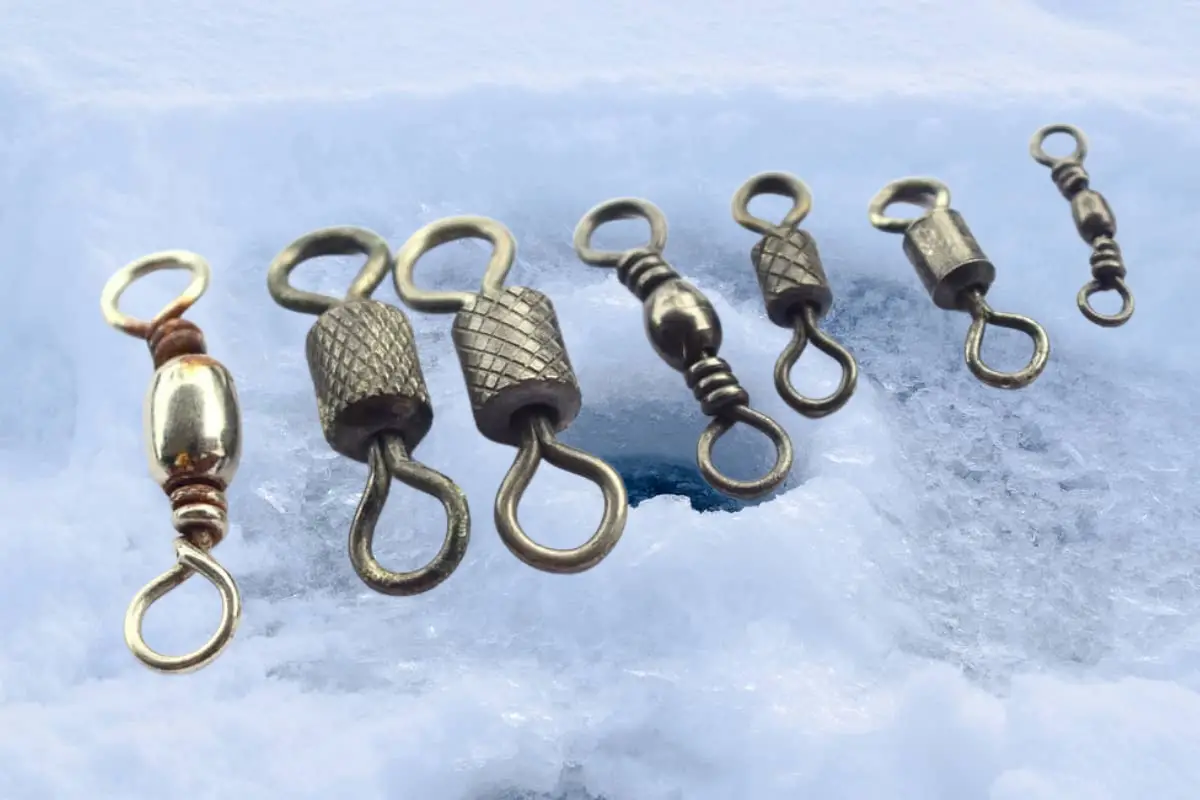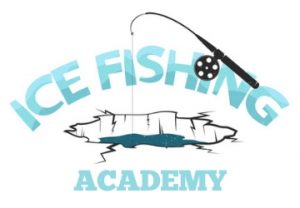The main concern during ice fishing is that the mainline may twist due to the spin of the lure bait, jig, etc. Using a swivel will keep this spinning from occurring. But which swivel and size should you use?
The size of the fish species determines the best size swivel for ice fishing use. The swivel strength should be slightly higher than the strength of the line and the leader line. Larger species require a more robust swivel, while lighter swivels can be used for smaller species.
Let me show you how your choice of swivel’s size affects your ice fishing. I will look at the most commonly used swivels, ball-bearing swivels, barrel swivels, snap swivels, and micro swivels and consider which swivel size is best for ice fishing.
What Is the Best Sized Swivel for Ice Fishing?
The size and type of swivel you’ll choose for ice fishing depends on the method used: tip-ups, ice traps, jigging, and ice-trolling. The other factor to consider is the fish species and size of fish you’re targeting.
Let’s take a look at the different types of swivels first, and if you’re in a hurry, there is a chart showing the best-sized swivels to use further down the article!

Best Size Barrel Swivels For Ice Fishing
Most barrel swivels are plated brass, and some swivels are nickel or stainless steel. Barrel swivels have limited rotation capabilities and offer little lure rotation control. Lighter barrel swivels are excellent for non-rotating lures and stealthy ice fishing.
Barrel swivels are available in a length range of 0.28″ (20 lb.) to 2.36″ (1223 lb.) and cater to fish of all sizes. While barrel swivels are cheaper than ball-bearing swivels, friction and metal fatigue may cause brass barrel swivels to suffer some wear and tear.
Best Size Ball-Bearing Swivels Used For Ice Fishing
Heavy, stainless steel, Ball-bearing swivels have polished ball bearings inside a drum. Ball-bearing swivels are fast in reaction, making them very useful for fast-lure movements but less suitable for a smaller lure that requires finesse and a non-rotating lure.
Anglers favor Ball-bearing swivels for spoons and jigs that are heavy and spin fast. Structurally, If swivel rings are not spot-welded, they may open under pressure.
The heavier, bulkier ball-bearing swivel is best for a bigger catch but not ideal for stealth ice fishing.
Ball-bearing swivels are available in a length range of 0.58″ (33 lb.) to 1.61″ (507 lb.) and cater to fish of all sizes. Although they are more expensive than barrel swivels, ball-bearing swivels offer a superior, smooth-spinning movement. The swivel’s eyelets spin independently.
Best Size Snap Swivels Used For Ice Fishing
Snap Swivels add a snap – a metal catch – to the lure on the one end and link with the mainline or leader at the other end. They are easy to use, popular, and available in every bait shop.
Snap Swivels’ primary function is to enable anglers to attach the lure without tying a knot and change the lure without cutting the line.
Anglers use snap swivels to limit lure spin or tangling and keep the leader and the mainline steady. Some anglers use a snap, on its own, on the end of the leader and a swivel linking to the end of the leader, making the lure look less bulky.
Other swivels are likely to hold against spin better than the snap swivels that could break. For this reason, anglers prefer to use snaps and snap swivels when ice fishing with a small lure, jig, and spoons.
Snap swivels are available in the length range of 1.06″ (26 lb.) to 3.9″ (503 lb.) and cater to fish of all sizes. Note that larger fish increase the danger of snap swivels’ breaking.
Pro Tip: When wanting only a quick way to change out spoons and jigs without the use of a snap swivel, I use Mustad Fastach Clips and get them straight from Amazon. Super quick and easy!
“A quick twist and the spoon or jig come right off the Fastach. I’ve used them for trophy walleye in Canada, lake trout in South Dakota, and northern pike in Montana! Perch and crappie hit smaller jigs just as hard too!
Best Size Micro Swivels Used For Ice Fishing
Micro Swivels are the smallest swivels anglers can use. Their length points to their primary function – stealth ice fishing. Micro swivels come in length ranges of between 0.29-inch (up to 25lb), 0.33-inch (up to 40 lb.), and 0.41-inch (up to 80 lb.) and cater to most mid-to-low fish weights.
Black stainless-steel micro swivels enhance strength and are corrosion resistant. Micro swivels offer a virtually invisible line and a low bulk profile when tied to a fluorocarbon leader.
Stronger Swivels Are Also More Visible
Since the size of the swivel is relatable to the leader’s strength, the angler chooses both according to the size of the fish one plans to catch.
For example, a 35 inch Northern Pike weighs 12.2 Lb., requiring a #12 size swivel, and a 50 inch Muskie weighing 33.1 Lb. on average, may snap any swivel that is smaller than #8.
While the size of the swivel gives the angler a greater chance of landing a trophy fish, the size of the swivel could also have a negative effect and scare the fish.
The angler needs to weigh the strength of the swivel versus the visibility of the presentation. The fish may snap a weak swivel even if it is well camouflaged.
Some anglers address the size vs. visibility challenge using a snap only to link the leader to the lure, and then anglers position a swivel between the leader and the mainline.
This rig makes the presentation less bulky, primarily if they use a Fluorocarbon line – which is virtually invisible – as a leader. All that is visible is the lure and the snap.
Matching Swivels To Popular Ice Fishing Species
Anglers must mix and match their tackle according to the type and size of fish they aim to catch. They also consider if the fish is ‘shy’ and requires a stealth technique.
There is no one-size-fits-all for swivels. Here is a table of the recommended swivel sizes for the species of fish you’re targeting.
| Fish | Fish Weight (lb) | Line Test (lb) | Line type | Swivel Type & Size |
| Yellow Perch | 1-3+ | 2-4 | Mono | Snap #0 Micro Small |
| Largemouth Bass | 2-13+ | 6-8 | Mono/ Braided | Barrel #10 |
| Smallmouth Bass | 1-4+ | 6-10 | Fluoro Leader | Ball- Bearing #0 |
| Walleye | 1-12+ | 8-12 | Fluoro | Barrel #10 |
| Lake Trout | 5-25+ | 12-15 | Fluoro Leader | Barrel #10 |
| Northern Pike | 2-30+ | 15-20 | Braided/ Fluoro Leader | Snap #0 |
| Rainbow Trout | 2-10+ | 4-30 | Mono/ Braided | Barrel #10 Or #12 |
Make Sure Swivels Of All Sizes Sink Fast When Required
An often asked question relates to the size and weight of the swivel concerning its ability to sink. The angler considers a sinking rig when it is necessary to lower and lift the rig quickly to catch fish like Perch and Walleyes, who move in schools.
Sinking rigs are also helpful when trying to attract fish’s attention by ‘pounding bottom’ to emulate the behavior of fish like Minnows, who turn up sand. Thirdly, anglers need to keep the line steady in currents, especially when using live bait.
Lastly, sinking rigs are helpful because they enable sinking without adding to the bulk of the rig, which is an excellent solution for anglers who wish to place their lure close to the bottom or pound it without presenting a large lure.
Conclusion
Think of the swivel as a spin-deflector. As you move your line to lure the fish, the jig may spin, and the fish is sure to put on a fight as you reel it up toward the hole. Having your leader attached to a swivel prevents your line from twisting and knotting.
Swivels allow the leader to move while keeping the mainline steady. Large-size, bulky swivels carry heavier loads. Smaller, easier to disguise swivels may be better suited to smaller fish.
Whether anglers use tip-ups or a jigging rod for ice fishing, their swivels will keep the line from tangling. Anglers often use the same swivel size unless they choose to replace their leader.
Have fun and stay safe out there!

